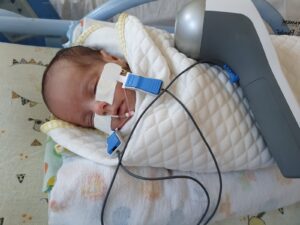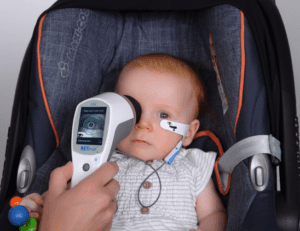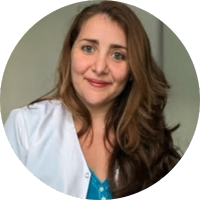The Use of RETeval ERG/VEP en oftalmología pediátrica
Interview with Dr. Ayelén Ginesta and Dr. Maria Ana Martínez

Entrevistador:
Welcome, Dr. Ginesta and Dr. Martínez! Thank you for joining us. Dr. Ginesta, could you start by introducing yourself?
Dr. Ayelén Ginesta:
I’m Ayelén Ginesta. I work at the Eye and Ear Institute, in Resistencia, Chaco, Argentina. I studied medicine at the National University of the Northeast (UNNE), where I currently teach, and completed my postgraduate degree at the Catholic University of Cordoba (UCC) on Advances in Pediatric Ophthalmology and Strabismus. I’m excited to share my experience with electroretinography (ERG), and how we’re able to use the RETeval en la práctica clínica, en especial, en casos con pacientes pediátricos.
Entrevistador:
Suena fascinante. ¿Podría hablarnos más acerca del papel de la electrorretinografía (ERG) en casos pediátricos?
Dr. Ayelén Ginesta:
Certainly. Electroretinography, or ERG, measures the retina’s electrical response to light. It tracks this response from the photoreceptors through to the optic nerve, providing a functional analysis of the entire visual pathway. Esto es fundamental en pediatría para diagnosticar y comprender afecciones que pueden no ser evidentes a simple vista. La ERG se puede utilizar para identificar enfermedades hereditarias de la retina, toxicidades retinales y otras afecciones sistémicas que se manifiestan en el ojo.
Entrevistador:
Las pruebas electrofisiológicas pueden suponer un reto. ¿Cómo ayuda RETeval a que la ERG sea accesible, especialmente para los pacientes más jóvenes?
Dr. Ayelén Ginesta:
Los dispositivos electrofisiológicos tradicionales son a menudo pesados, requieren una cooperación significativa del paciente y pueden ser costosos, lo cual limita su disponibilidad, sobre todo en América Latina. Sin embargo, RETevalsimplifica el proceso It doesn’t need corneal contact electrodes, instead using adhesive Sensor Strips that are particularly well-suited for pediatric patients, including infants. I even call them “stickers” to make it fun for kids. Estas tiras las llamo "pegatinas" para que sea divertido para los niños. La configuración es rápida y mínimamente invasiva, siendo así menos intimidatoria y más práctica.
Dr. María Ana Martínez:
La La portabilidad de RETeval’s portability means we can conduct exams outside the traditional clinical setting. Por ejemplo, en mi consulta, llevamos con facilidad el dispositivo a entornos quirúrgicos sin ninguna carga logística o lo utilizamos, and we can use it in situations with children with special needs, like autism or cerebral palsy. This accessibility is invaluable when we’re working with children who may find clinic visits stressful.
Entrevistador:
Dr. Martínez, could you share more about your background and how RETeval se utiliza en su trabajo con la retinopatía del prematuro (ROP) y otras condiciones?
Dr. María Ana Martínez:
I’m a specialist in pediatric retinal conditions. I studied Medicine at the Autonomous University of the State of Mexico and Ophthalmology at the Central Military Hospital. I trained in pediatric retina at top institutions, including NewYork-Presbyterian Hospital and Children’s Hospital Los Angeles. I currently work at the Association to Prevent Blindness in Mexico (APEC). I have my own clinic in Toluca, where I specifically treat ROP.
Esta condición tiene una prevalencia significativamente más alta en América Latina con menos disponibilidad de recursos para manejar la enfermedad que en regiones más desarrolladas. Por lo tanto, muchos niños desarrollan ROP estadio 5, que no sólo causa ceguera, sino que también conlleva el potencial de efectos secundarios como dolor severo, pérdida del ciclo circadiano, catarata, glaucoma y otros. Nos especializamos en el tratamiento quirúrgico de estos casos, que a menudo se complican por la presencia de autismo o parálisis cerebral. Gracias al RETeval, podemos evaluar la función visual y la percepción de la luz que podrían preservarse con cirugía, lo cual ayuda a decidir las intervenciones en estas situaciones..

Bebé prematura con electrodos de pequeño tamaño: Sensor Strips
Entrevistador:
Parece que ambas han utilizado RETeval con casos diversos. ¿Podrían compartir algún ejemplo concreto en el que haya resultado especialmente útil?
Dr. Ayelén Ginesta:
Hace poco se presentó un niño de 8 años con disminución de la agudeza y alteración de la visión de los colores, esto nos hizo sospechar de una distrofia de conos. Utilizando la ERG de campo completo de RETeval’s full-field ERG, we confirmed abnormalities in both rod and cone functions, guiding us toward the diagnosis. The device’s ability to deliver fast, detailed data allowed us to start a tailored management plan immediately.
Dr. María Ana Martínez:
I would love to share two examples of children I was recently managing. One is a three-year-old boy who had aggressive ROP requiring laser and anti-VEGF. We performed a VEP with the RETeval en el pequeño, encontrando una respuesta razonablemente buena. Este hallazgo contrasta con el segundo caso, un niño de un año y medio con ROP en estadio 4 en ambos ojos. Tras realizar la PEV en este niño, no se observó respuesta en un ojo, pero sí resultados razonablemente buenos en el otro. Este niño se sometió a una intervención quirúrgica en el ojo que veía mejor para mantener el máximo de visión posible.
RETeval ERG/VEP en oftalmología pediátrica
Obtenga más información sobre el uso de RETeval con pacientes pediátricos
Entrevistador:
RETeval tiene claramente ventajas clínicas. Más allá de la facilidad del proceso de diagnóstico y de la toma de decisiones clínicas, ¿existen otros beneficios de su uso con pacientes pediátricos?
Dr. Ayelén Ginesta:
Efectivamente, con RETeval, we can perform ERG in a way that is engaging and non-intimidating for young children. The device works even with the child sitting on a parent’s lap, which is invaluable for children who need reassurance. And because it’s such a quick test, we often complete it before the child even realizes they’re being examined.

Examen ERG en un portabebés utilizando un RETeval
Dr. María Ana Martínez:
For me, the device’s non-restrictive design means we can work anywhere without logistic challenges, even with children who may have additional neurological conditions. We’ll just pack the device and go into the specific surgery room, or stay within the exam room and not have to move into a special testing location. In addition, it is the objectivity of the assessment that is truly valuable. For example, many of these children are unable to communicate whether they can see light or not, yet light perception can be important for circadian rhythm regulation, which supports hormone and growth regulation. RETeval lets us assess this perception and understand how the eye and brain are working together, even when the child can’t communicate.
Entrevistador:
Dada la utilidad y flexibilidad de RETeval’s utility and flexibility, what advice would you offer other pediatric ophthalmologists who may be considering it?
Dr. Ayelén Ginesta:
I would say, don’t hesitate to explore it! This device makes complex retinal assessments accessible, even for children. And because it’s fully portable and battery-operated, it’s especially valuable in regions where access to specialized ophthalmology services might be limited.
Dr. María Ana Martínez:
Sí, además, el dispositivo nos permite conocer la función en casos que de otro modo podrían pasar desapercibidos o resultar imposibles de comprobar. Pensemos en añadir una herramienta objetiva para niños que pueden tener muchas dificultades diversas, como limitaciones del cuello o inmovilidad o déficits neurológicos. Añadir el RETeval a nuestra cartera nos proporciona una herramienta objetiva y de alta calidad, no sólo para el diagnóstico, sino también para las decisiones preoperatorias y el seguimiento del tratamiento.
Entrevistador:
Gracias a ambas por esta perspicaz conversación y por compartir las formas en que RETeval ayuda en el avance de la oftalmología pediátrica.

Dr. Ayelén Ginesta
The Eye and Ear Institute in Resistencia, Chaco, Argentina
I am Ayelén Ginesta, a physician specializing in Ophthalmology and Pediatric Ophthalmology. I work at the Eye and Ear Institute in Resistencia, Chaco, Argentina. I studied medicine at the National University of the Northeast (UNNE), where I currently teach.
I completed my specialist postgraduate degree at the Catholic University of Córdoba (UCC), where I am currently pursuing an advanced update postgraduate course in Pediatric Ophthalmology and Strabismus.

Dr. Maria Ana Martínez
Star Medica Hip Hospital, México
María Ana Martínez-Castellanos is an accomplished ophthalmologist specializing in Retinopathy of Prematurity (ROP) and Medical and Surgical Retina. She studied Medicine at the Autonomous University of the State of Mexico and Ophthalmology at the Central Military Hospital. She further trained in Pediatric Retina at top institutions, including New York Presbyterian Hospital and the Children’s Hospital of Los Angeles. Currently, she works at the Association to Prevent Blindness in Mexico (APEC) and has established her own clinic in Toluca, equipped for premature infants. She is also involved in opening a pediatric retina medical-surgical area at APEC.
María Ana, influenced by mentors like her father and Hugo Quiroz, is dedicated to advancing ophthalmology in Latin America through global integration and telemedicine. Internationally recognized for her research on ROP, she remains committed to improving healthcare in Mexico. Passionate about golf, art, and collecting illustrated books, she is a multifaceted professional dedicated to both her career and personal interests.
